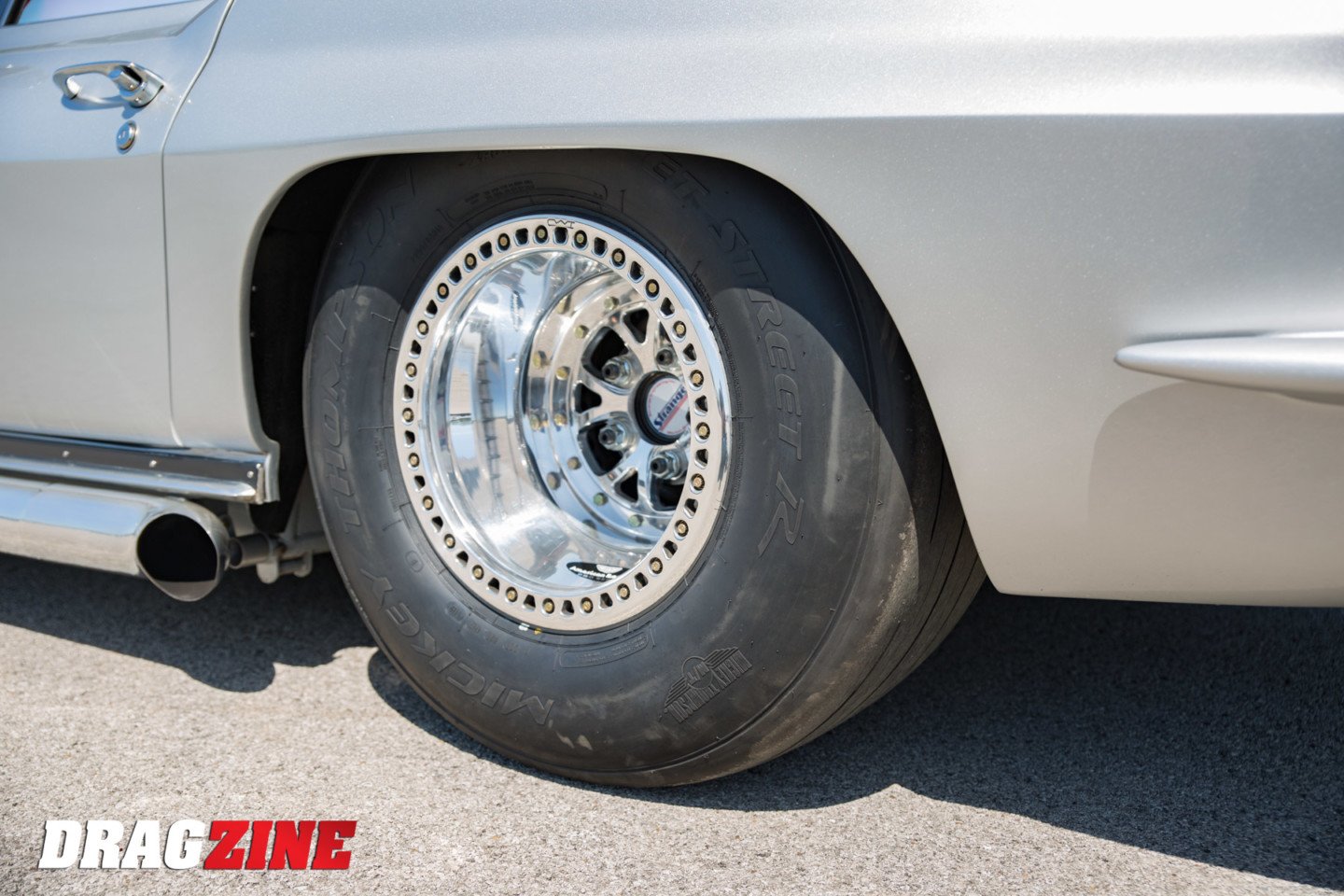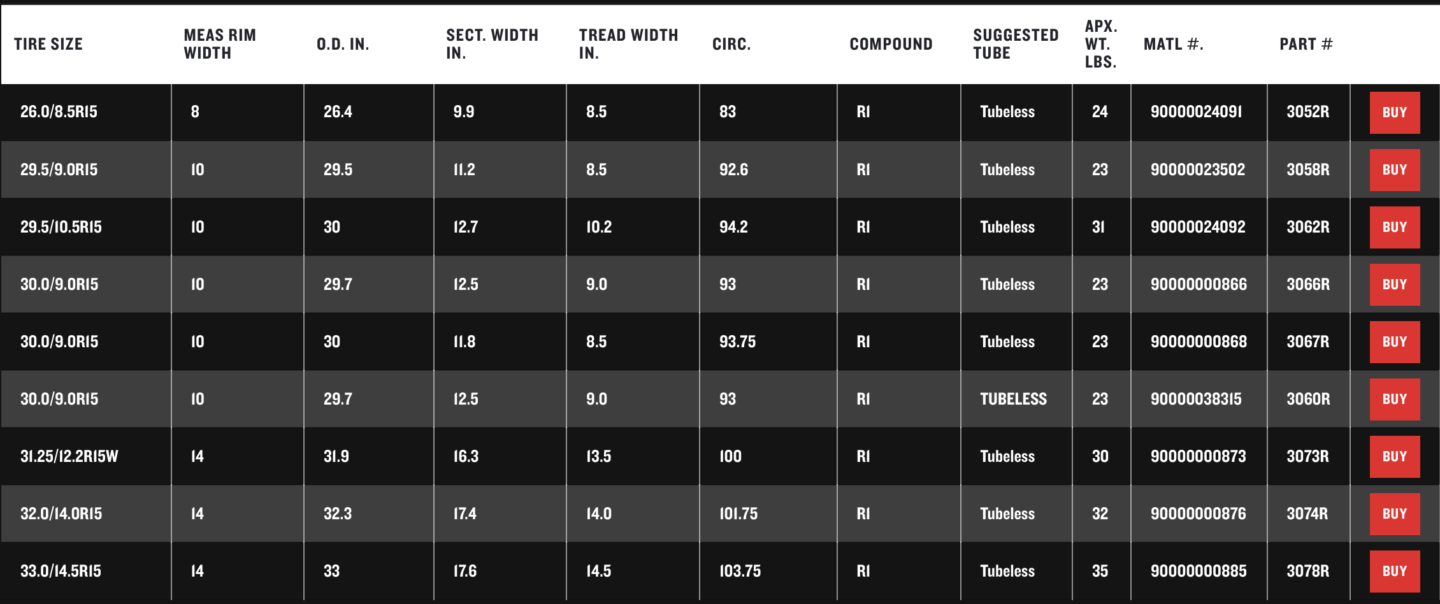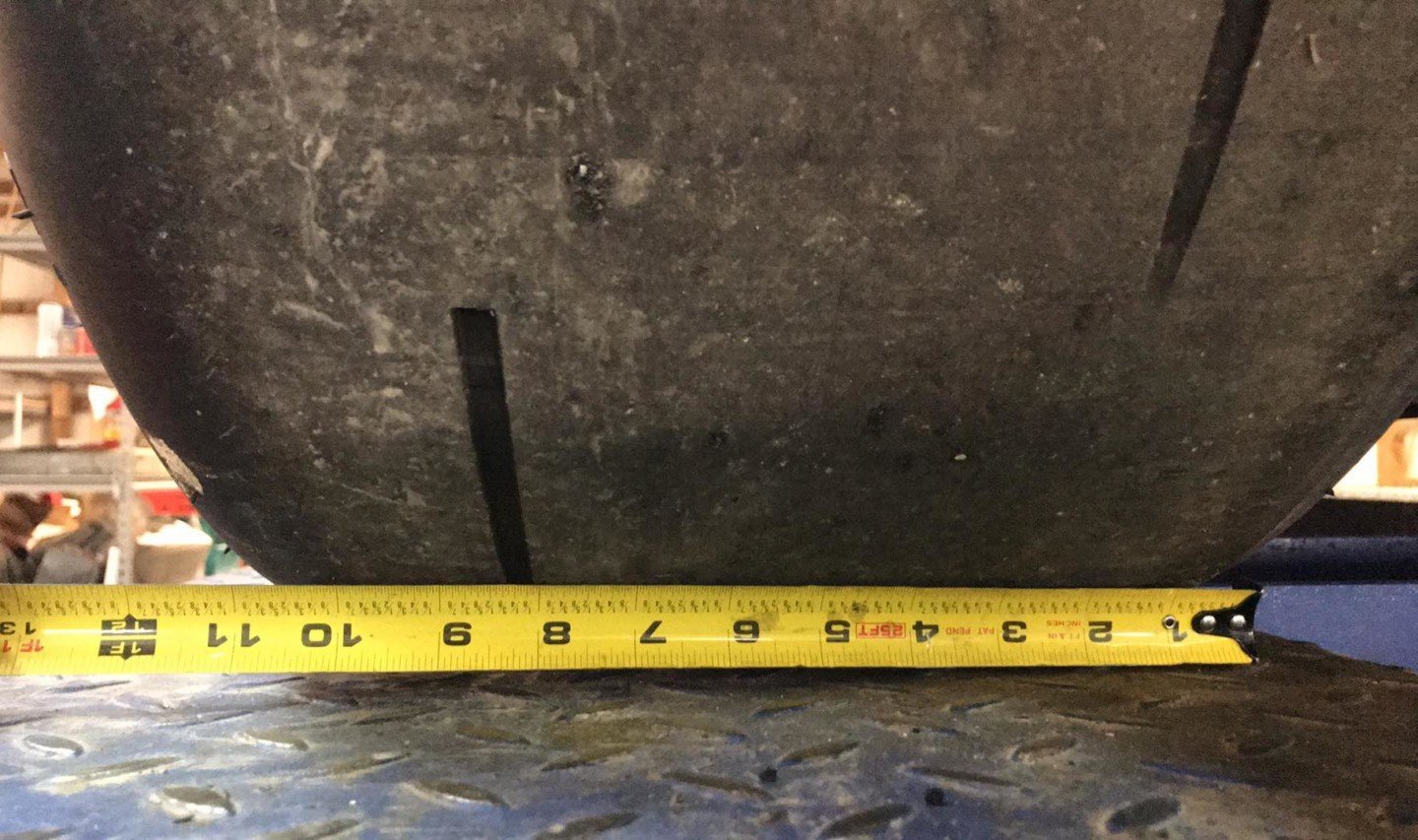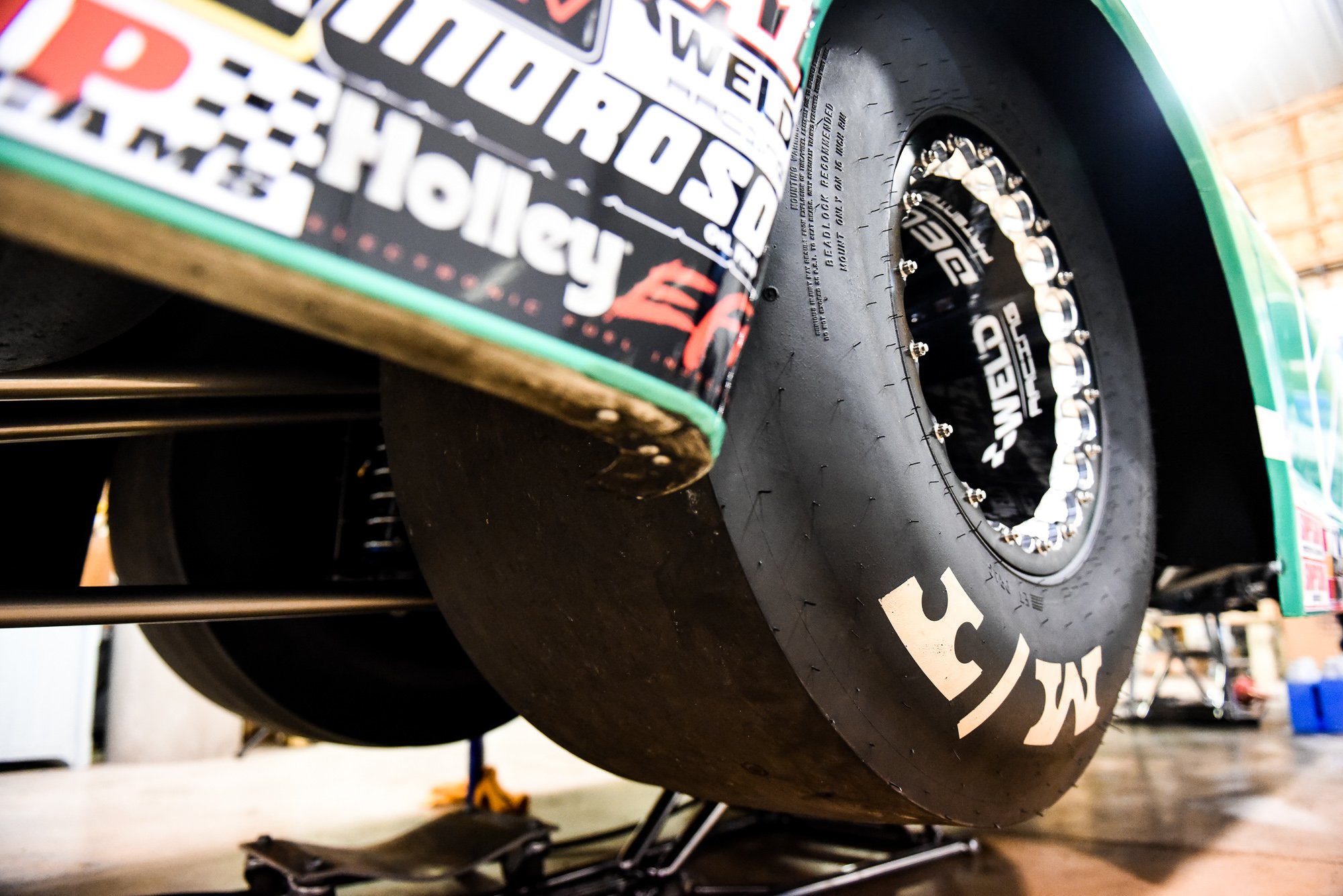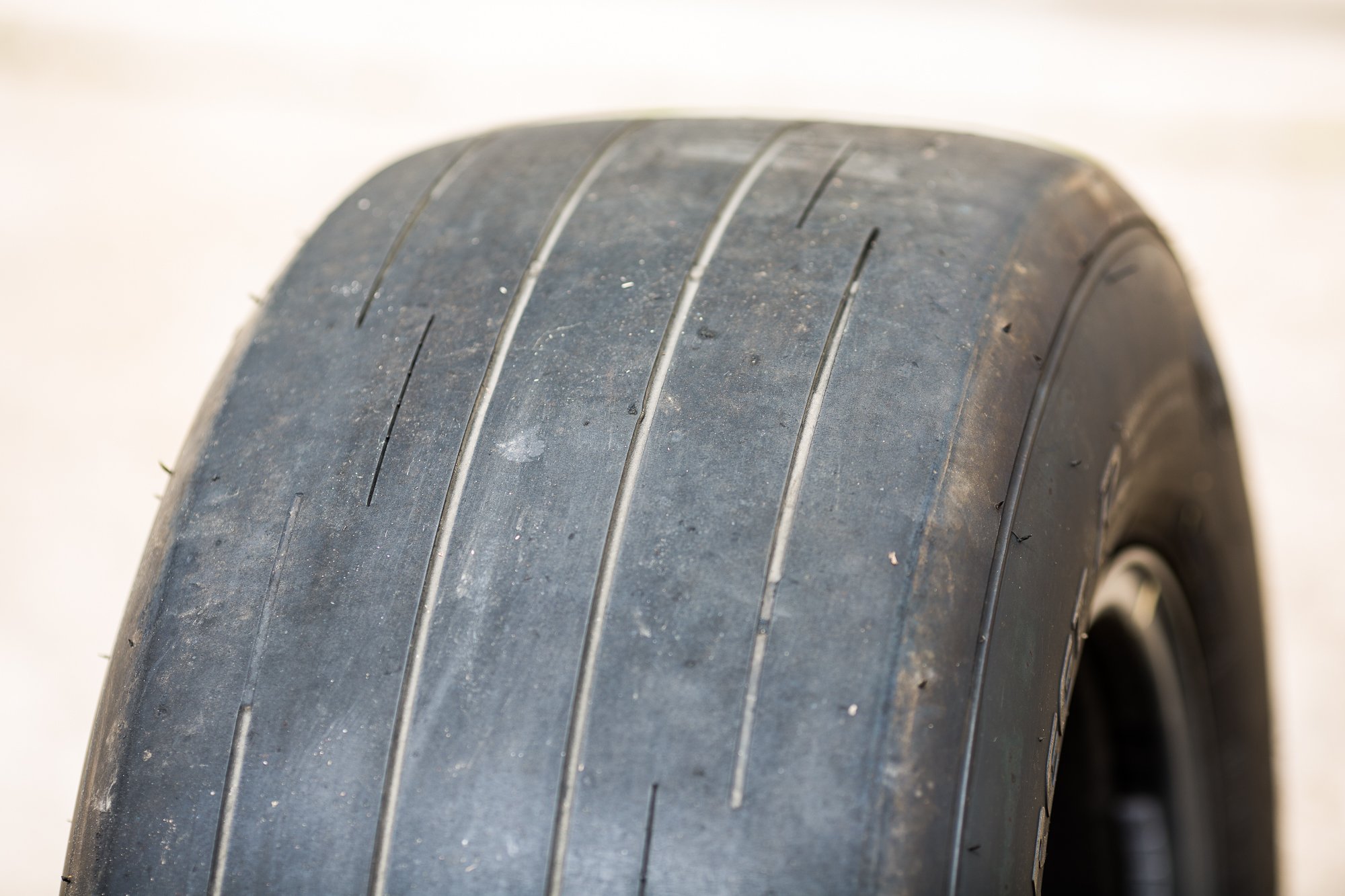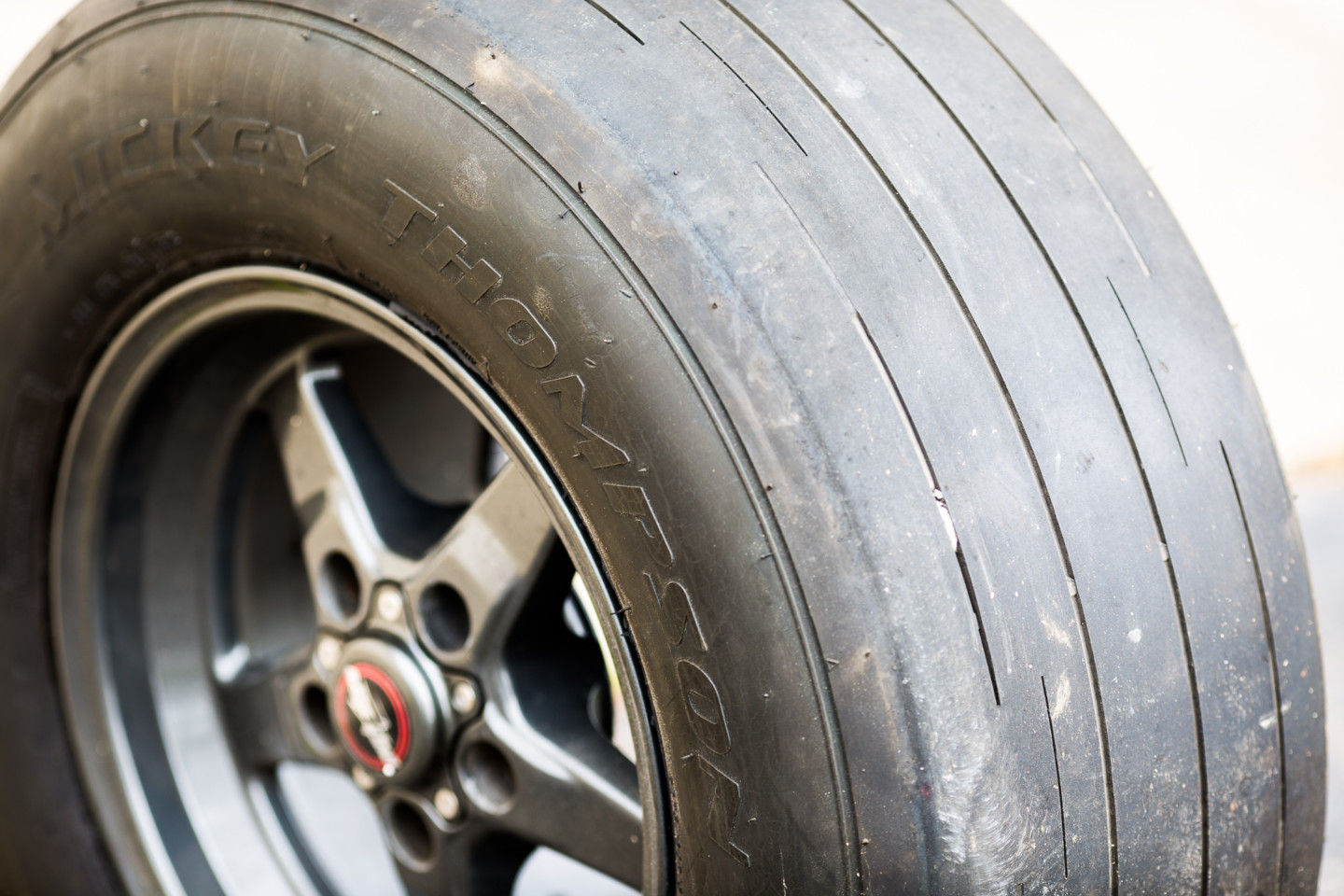Racers will be racers, pushing the boundaries of each and every part on their machines to gain a mechanical edge. Wheels and tires are no exception to this, and despite published standards on wheel width in relation to tire width — a number determined by third-party highway safety regulators — racers have largely scienced-out wheel and tire combinations to achieve the desired traction and drivability characteristics without exceeding structural limitations. But how wide is too wide, how can you ensure your safety, and what do all those numbers mean that you see on tire catalog charts?
Tom Kundrik, the track support guru from Mickey Thompson Performance Tires & Wheels, has had his hands all over the company’s tires in every segment of the sport that they’re used, and he sat down to share a bit of his extensive knowledge with us on the topic of wheel and tire width combinations.
This is an important topic, in particular, because the direction that racers are going with their wheel-to-tire measurements lis leaning toward a point at which catastrophic failure can occur of proper steps are not in place. As conventional wisdom tells us, and Kundrik confirms, tread width and overall footprint can be expanded by increasing wheel width. Racers have found that, in certain tires, 1-inch of wheel width beyond the recommended wheel size can add up to as much as 1/4-inch of tread on the racing surface. This number can vary depending on tire pressure and tire size, but is a general yardstick. The end result is more tire on the ground, and in tire-limited categories — typically drag radial or 10.5-inch tire racing — every minute amount of traction helps. But, structurally, going wide is more dangerous than going narrow if the tire is not properly secured to the wheel, and that’s why the Tire & Rim Association develops standards that manufacturers like Mickey Thompson must adhere to.
That said, racers still push the issue, and because it isn’t something that’s enforced, it’s really up to the racers individually to decide what to run.
Beyond it putting more tire on the ground — in some cases a ton more tire — stretching the tire out also takes some of the flex out of it. – Tom Kundrik
“There are guys putting 275/60/15 Pro Drag Radials on 15×15-inch wheels; 15-inch by 13- or 14-inches wide is pretty common, but as a manufacturer, we can’t recommend they do that. We have to abide by the Tire & Rim Association, whose engineers develop these standards for the purpose of safety,” Kundrik says.
“The numbers in the catalog are devised by the Rim & Wheel Association, and those are the wheel widths that they’ve deemed those tires belong on,” Kundrik continues. “Anything we recommend is what they say is acceptable. When you get a tire on a wheel with a beadlock, it’s a bit of a different story; but some people take the numbers to heart, when they’re really supposed to be on a beadlock, and that’s where where you run into issues.”
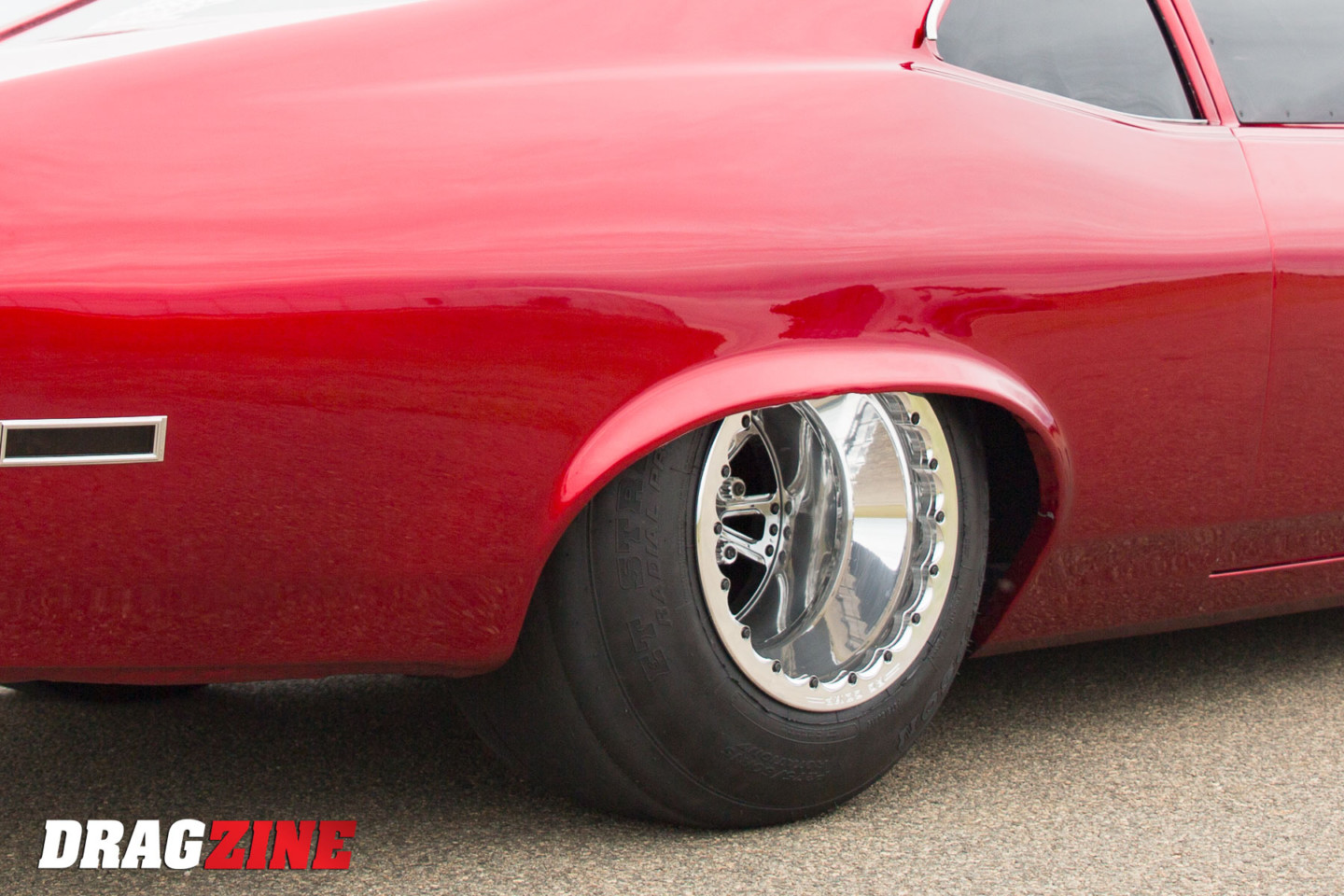
Notice, by the shape of the sidewall, the amount of stretching performed on these 275 Pro Drag Radials on the no-time Nova of Roger Holder.
Kundrik goes on to share, “what happens with the safety beads on the wheels, when you don’t have beadocks, is that going too wide can suck the tire right off the wheel at speed.” Kundrik says this is the case with both bias-ply and radials.
“Beadlocks allow you to get away with a little more, because it’s locked into place. With a rim screw [Kundrik emphasizes here to never run rim screws with a radial, as the screws will catastrophically tear the bead wire –trust him, he’s seen it] the tire can still pull itself off the wheel, but a beadlock, if properly installed, you’re not going to get the tire coming off that wheel.”
Mickey Thompson’s official stance is for wheels to exceed tread width by not more than 1-inch in either direction. But, again, racers will be racers.
Rim screws, less common in the age of beadlock wheels and wheel conversions, can be a hazard with slicks if too wide of a wheel is used, as a result of both the angle of the sidewall and bead to the tire, and pure centrifugal force. As Kundrik points out, the effectiveness of the screws, at a certain point, is diminished entirely as the tire is naturally being forced off of the wheel at speed.
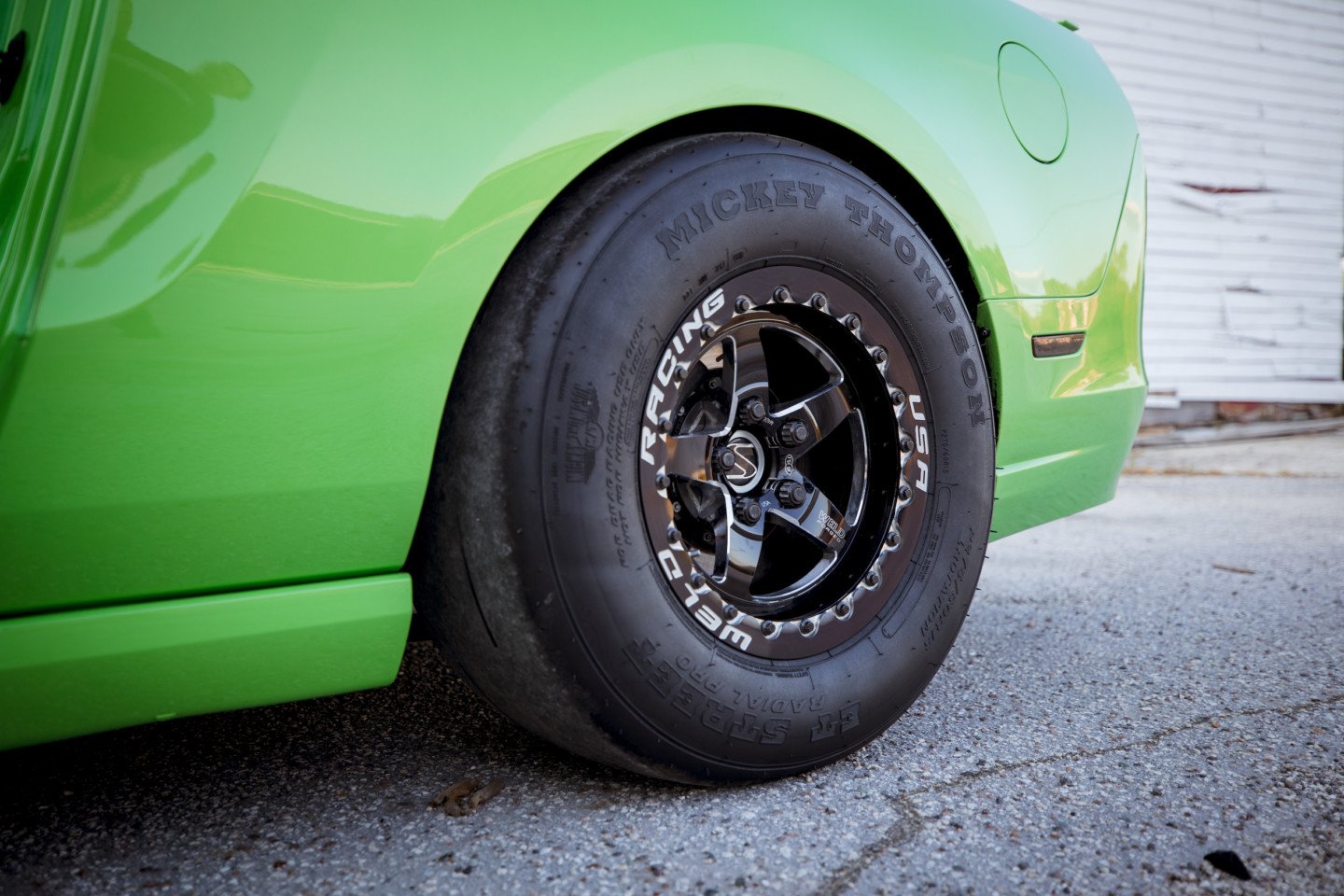
A street application simply cannot safely exploit the limitations of a tire quite like a race-only vehicle can, thus the more conservative wheel width on this car versus that of Holders’ Nova, with the very same tire.
In looking at the numbers in any M/T tire catalog, you’ll first see Measured Rim Width, which is the wheel width that the Tire & Rim Association has determined is best-use for that tire. Using the 3062R, as an example, the de facto standard in Radial versus The World, a 10-inch wheel is recommended. Moving across the chart, Section Width is the measurement from inner to outer sidewall, when the tire is mounted on a 10-inch wheel. Accordingly, the Tread Width is just that, the width of the tread that touches the racing surface, when mounted on a 10-inch wheel.
But Radial versus The world competitors often run up to a 15-inch wheel, which stretches out both the Section Width and Tread Width — at 15-inches, the tread, in theory, could be increased as much as 1.25-inches, to 11.45-inches wide. These numbers, again, are based on theory and may vary, and are not confirmed or officially supported by Mickey Thompson. A sample measurement made on a 3062R with a 13-inch wheel by a Radial versus The World competitor provided us a rough measurement of 10.75-inches of tread width, or .55-inches wider than spec. Section Width will increase roughly 0.4-inches for every 1-inch of wheel width beyond standard, as well. Section Width, it should be noted, can be valuable in ensuring the wheel and tire will fit on the car without rubbing the quarter panel.
But this new approach to wheels and tires isn’t just about contact patch, but also about power-application characteristics.
“Beyond it putting more tire on the ground — in some cases a ton more tire — stretching the tire out also takes some of the flex out of it,” Kundrik explains. “This helps the tire ‘stay round’ and maximizes the footprint though the rotation. The way you run a radial car, for example, with dead-hooking, it doesn’t have any wheel speed and the tire is hooked and moving from the get-go.”
Bias-ply slicks, with a sharp lip separating the tread from the sidewall, are pretty straightforward when measuring tread width. A radial, meanwhile, with a rounded, less pronounced transition, requires one to put five to six runs on the tire and then measure the width of the wear pattern.
To an extent, Kundrik says the fact that radials grow very little at speed has allowed teams to get away with stretching the tire well beyond its published capability. But even bias-ply (slick tire) racers have been following the trend, albeit not as significantly, in order to gain tread width, but moreso, to assist in power application.
“A lot of Pro Modified racers with 17-inch wide tires, who used to run 16×16-inch wheels, are now running a 16×18. And it’s worth some e.t. for those guys,” he says. “On the radial, it doesn’t change the characteristics much, but on slicks, it helps to keep the tire stretched out, and the big-tire guys are finding that it helps them with tire-shake, in two ways: one, it helps the tire stay round by not allowing the sidewall to deflect as much in a longitudinal direction. And second, it also makes the volume inside the tire larger, making the tire think it’s bigger and allowing for lower inflation pressure.”
“With tire-shake, the less amount of air you can get within the tire, the less amount of space between the rim and the tire, and it’s really a tremendous help in that scenario,” Kundrik continues.
Given all that’s been presented, it’s unlikely anyone reading this is going to run out and purchase a wheel that’s too narrow, but what are the consequences of going back in the other direction, if you’re curious?
“On a slick, it would get floppy and actually crown the tire and you won’t get much tread width out of it. A radial would really do the same thing with the crowning. It would, likewise, change the driving characteristics of the car, so we’d advise staying above the recommended rim width at the very least, for a variety of reasons.” he explains.
So, should you move to w diet wheel and in crease your footprint? As with most things, that depends. While stretching a tire has generally been found to have advantages across the board for pure drag racing applications, that’s not particularly the case for applications that see street use, where drivability and longevity remain key.
“I’ve got friends that drive street cars around, and they call me up and say, ‘hey, I know those 275 guys run these things on 13-inch wide wheels, can I do that?’ And I’m quick to tell them, no. You just don’t want to do that,” Kundrik says.
Heads-up guys obviously lead the pack…they’re the first ones to try something and push the envelope, but that later trickles down to the sportsman racers. – Tom Kundrik
“You can get away with going a couple of inches wider on a racecar with beadlocks — an 8.5-inch tire, you can get away with a 10. Or a 275…a 12-inch wheel is probably the maximum. A 315 is generally advised in the 12-14-inch wide window safely,” he explains.
Bracket racers, who aren’t as focused on outright performance nor are limited in tire size, tend not to push the boundaries simply because they don’t need to, but Kundrik says he finds some racers borrowing on the tricks founds in heads-up eliminators.
“Some of them do go wider. Most of those guys, they’re running a 29.5/10.5 or something, and they’ll run a 12, even a 13, and some have ventured to 14. Heads-up guys obviously lead the pack…they’re the first ones to try something and push the envelope, but that later trickles down to the sportsman racers —Top Dragster, Top Sportsman, index racers, we’re finding.”
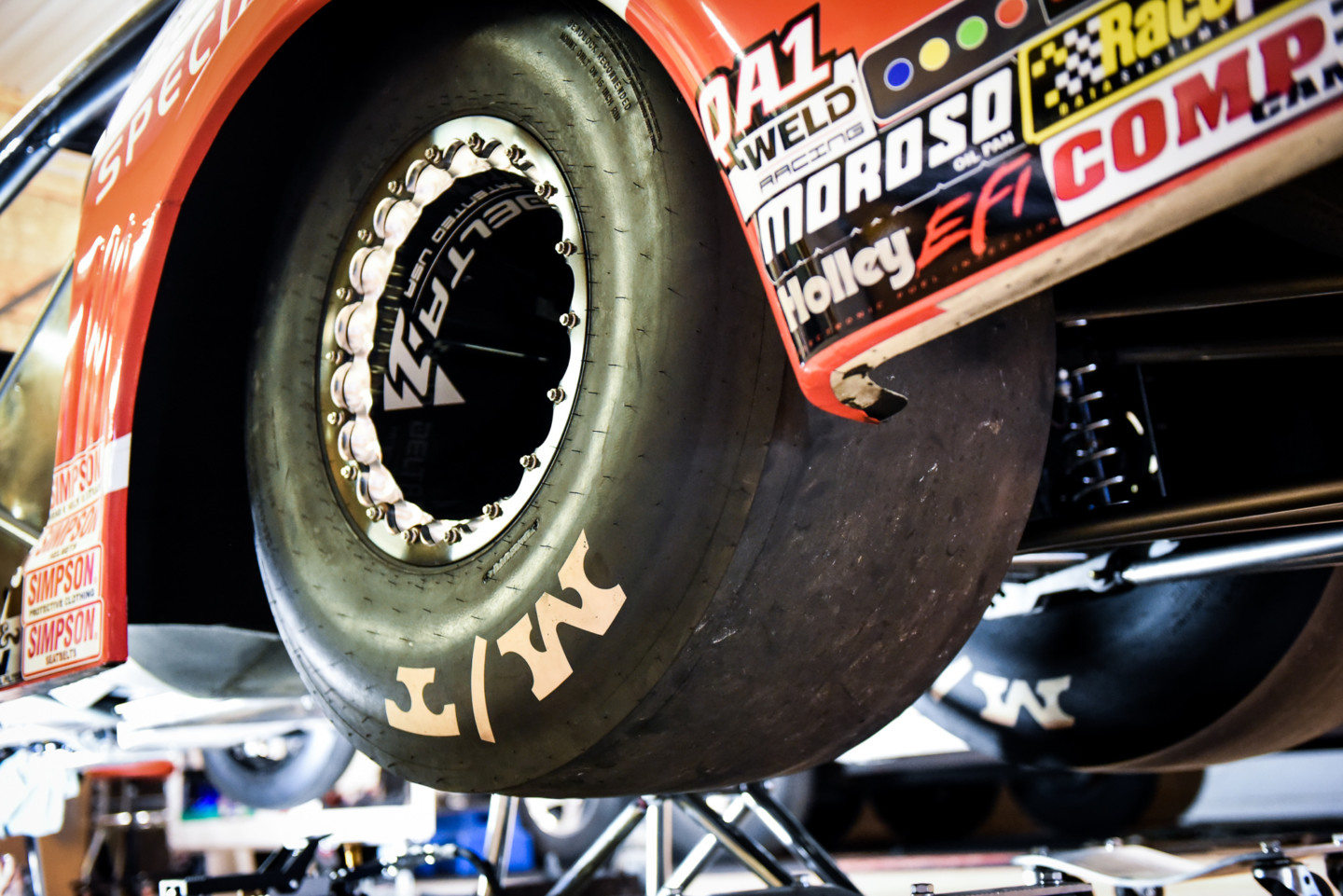
NHRA Top Sportsman racer Don O’Neal utilizes a 3197 “Big Bubba” ET Drag tire, measuring an 18.6-inch section with and 14.5-inch tread width, on a recommended 16-inch wide wheel. The “Bubba” tires borrow on the 33×10.5W tire design, and the wide-wheel standard does require they be used with beadlocks.
At the end of the day, it’s all about maximizing the potential of the tools at your disposal, and while Mickey Thompson is adamant about adhering to safety regulations, such regulations and even rulebooks have never stopped racers from devising new ways to coax performance out of their machines and pushing to the very edge. Burt nevertheless, if you’re selecting a wheel and tire setup for your car, be it street, strip, or both, it’s always wise to heed advice and put proper measures (no pun intended) in place before you get yourself into trouble.

